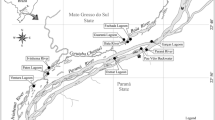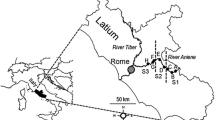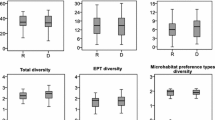Summary
Experimental studies were used to examine the mechanisms governing the distribution and abundance of two major patch types in unshaded reaches of Augusta Creek, Michigan (USA). One patch type is dominated by Cladophora glomerata, a macroalga potentially able to monopolize space, whereas the other type is comprised of a low-growing, epilithic microalgal lawn inhabited by several species of sessile grazers (especially the caddisflies Leucotrichia pictipes and Psychomyia flavida). Cladophora patches are absent from mid-channel sites characterized by current velocities ≤ ca. 50 cm s−1; caging experiments indicate that their absence is due to grazing by crayfish (Orconectes propinquus). Cladophora's presence in sites with velocities >50 cm s−1 apparently results in part because crayfish foraging activity is impaired in high flow regimes. The presence of Cladophora strongly affects various other invertebrates due to its alteration of abiotic and biotic characteristics of the microhabitat. For example, the abundance of sessile grazers (e.g. Leucotrichia and Psychomyia) that inhabit microalgal patches is negatively correlated to the abundance of Cladophora, whereas the abundance of several other invertebrates (e.g. Stenonema mayflies and Taeniopteryx stoneflies) is positively correlated to Cladophora's abundance. Therefore, in some portions of this system, crayfish act as keystone predators because of their ability to regulate the abundance of Cladophora, which in turn has strong positive and negative effects on other components of the community. Cladophora does not always monopolize space at high velocities in the absence of crayfish, however. If sessile grazers arrive at such sites before Cladophora, they can prevent its establishment. Thus, where crayfish are absent, the likelihood that a site will be dominated by either Cladophora patches or sessile grazer — microalgal lawn patches depends on two sets of stochastic processes: (1) those that create bare space (e.g. disturbance and grazer emergence); and (2) those controlling the timing of recruitment by Cladophora or grazers at these bare sites. These priority effects (i.e. the ability of grazers and Cladophora to inhibit each other's establishment) contribute to the marked spatial heterogeneity of these two patch types. Collectively, these results demonstrate how interactions between competition, predation, and physical factors can generate a complex mixture of community patterns.
Similar content being viewed by others
References
Buchanan TJ, Somers WP (1969) Discharge measurements at gaging stations. US Geol Survey Techniques Water-Resources Inv, book 3, chap A8, 65p
Capelli GM (1980) Seasonal variation in the food habits of the crayfish Orconectes propinquus (Girard) in Trout Lake, Vilas County, Wisconsin, U.S.A. (Decapoda, Astacidae, Cambaridae). Crustaceana 38:82–86
Connell JH, Slatyer RO (1977) Mechanisms of succession in natural communities and their role in community stability and organization. Am Nat 111:1119–1144
Creed RP Jr (1990) The direct and indirect effects of omnivorous crayfish on stream benthic communities. Dissertation, Michigan State University, East Lansing, Michigan
Crowl TA, Schnell GD (1990) Factors determining population density and size distribution of a freshwater snail in streams: effects of spatial scale. Oikos 59:359–367
DeNicola DM, McIntire CD (1991) Effects of hydraulic refuge and irradiance on grazer-periphyton interactions in laboratory streams. J N Am Benthol Soc 10:251–262
Dineen CF (1951) A comparative study of the food habits of Cottus bairdii and associated species of Salmonidae. Am Midl Nat 46:640–645
Dixon WJ (1988) BMDP statistical software manual. University of California Press, Berkeley, California, USA
Dodds WK (1991) Community interactions between the filamentous alga Cladophora glomerata (L.) Kuetzing, its epiphytes, and epiphyte grazers. Oecologia 85:572–580
Downes BJ (1990) Patch dynamics and mobility of fauna in streams and other habitats. Oikos 59:411–413
Dudley TL, Cooper SD, Hemphill N (1986) Effects of macroalgae on a stream invertebrate community. J N Am Benthol Soc 5:93–106
Dudley TL, D'Antonio CM (1991) The effects of substrate texture, grazing, and disturbance on macroalgal establishment in streams. Ecology 72:297–309
Dunson WA, Travis J (1991) The role of abiotic factors in community organization. Am Nat 138:1067–1091
Fauth JE, Resetarits WJ Jr (1991) Interactions between the salamander Siren intermedia and the keystone predator Notophthalmus viridescens. Ecology 72:827–838
Feminella JW, Resh VH (1991) Herbivorous caddisflies, macroalgae, and epilithic microalgae: dynamic interactions in a stream grazing system. Oecologia 87:247–256
Giller PS, Gee JHR (1987) The analysis of community organization: the influence of equilibrium, scale and terminology. In: Gee JHR and Giller PS (eds) Organization of Communities: Past and Present. Blackwell, Oxford, pp 519–543
Hansen RA, Hart DD, Merz RA (1991) Flow mediates predatorprey interactions between triclad flatworms and larval black flies. Oikos 60:187–196
Hart DD (1985a) Grazing insects mediate algal interactions in a stream benthic community. Oikos 44:40–46
Hart DD (1985b) Causes and consequences of territoriality in a grazing stream insect. Ecology 66:404–414
Hart DD (1987) Experimental studies of exploitative competition in a grazing stream insect. Oecologia 73:41–47
Hart DD, Robinson CT (1990) Resource limitation in a stream community: phosphorus enrichment effects on periphyton and grazers. Ecology 71:1494–1502
Hart DD, Kohler SL, Carlton RG (1991) Harvesting of benthic algae by territorial grazers: the potential for prudent predation. Oikos 60:329–335
Hildrew AG (1992) Food webs and species interactions. In: Petts GE and Calow P (eds) The Rivers Handbook. Blackwell, Oxford (in press)
Howard AE, Nunny RS (1983) Effects of near-bed current speeds on the distribution and behaviour of the lobster, Homarus gammarus (L.). J Exp Mar Biol Ecol 71:27–42
Koster WJ (1937) The food of sculpins (Cottidae) in central New York. Trans Am Fish Soc 66:374–382
LaLonde RT, Morris CD, Wong CF, Gardner LC, Eckert DJ, King DR, Zimmerman RH (1979) Response of Aedes triseriatus larvae to fatty acids of Cladophora. J Chem Ecol 5:371–381
Lodge DM, Lorman JG (1987) Reductions in submersed macrophyte biomass and species richness by the crayfish Orconectes rusticus. Can J Fish Aquat Sci 44:591–597
Loeb SL (1981) An in situ method for measuring the primary productivity and standing crop of the epilithic periphyton community in lentic systems. Limnol Oceanogr 26:394–399
Lubchenco J, Menge BA (1978) Community development and persistence in a low rocky intertidal zone. Ecol Monogr 48:67–94
Lubchenco J, Gaines SD (1981) A unified approach to marine plant-herbivore interactions. I. Populations and communities. Ann Rev Ecol Syst 12:405–437
MacArthur RH (1972) Strong, or weak, interactions? Trans Conn Acad Arts Sci 44:177–188
Maude SH, Williams DD (1983) Behavior of crayfish in water currents: hydrodynamics of eight species with reference to their distribution patterns in southern Ontario. Can J Fish Aquat Sci 40:68–77
McAuliffe JR (1984) Competition for space, disturbance, and the structure of a benthic stream community. Ecology 65:894–908
Menge BA (1978) Predation intensity in a rocky intertidal community. Relation between predator foraging activity and environmental harshness. Oecologia 34:1–16
Menge BA, Sutherland JP (1987) Community regulation: variation in disturbance, competition, and predation in relation to environmental stress and recruitment. Am Nat 130:730–757
Munger JC, Brown JH (1981) Competition in desert rodents: an experiment with semipermeable exclosures. Science 211:510–512
Paine RT (1966) Food web complexity and species diversity. Am Nat 100:65–75
Palmer MA (1988) Epibenthic predators and marine meiofauna: separating predation, disturbance, and hydrodynamic effects. Ecology 69:1251–1259
Patrick R, Rhyne CF, Richardson RW III, Larson RA, Bott TL, Rogenmuser K (1983) The potential for biological controls of Cladophora glomerata. EPA-600/3-83-065. U.S. Environmental Protection Agency, Washington, D.C.
Peckarsky BL (1983) Biotic interactions or abiotic limitations? A model of lotic community structure. In: Fontaine TD, Bartell SM (eds) Dynamics of Lotic Ecosystems, Ann Arbor Science, Ann Arbor, Michigan pp 303–323
Peckarsky BL, Horns SC, Statzner B (1990) Stonefly predation along a hydraulic gradient: a field test of the harsh-benign hypothesis. Freshwat Biol 24:181–191
Poff NL, Ward JV (1989) Implications of streamflow variability and predictability for lotic community structure: a regional analysis of streamflow patterns. Can J Fish Aquat Sci 46:1805–1818
Power ME (1987) Predator avoidance by grazing fishes in temperate and tropical streams: importance of stream depth and prey size. In: Kerfoot WC, Sih A (eds) Predation: direct and indirect impacts on aquatic communities. University Press of New England, Hannover, New Hampshire, pp 333–351
Power ME (1990a) Effects of fish in river food webs. Science 250:811–814
Power ME (1990b) Benthic turfs vs floating mats of algae in river food webs. Oikos 58:67–79
Power ME, Matthews WJ, Stewart AJ (1985) Grazing minnows, piscivorous bass, and stream algae: dynamics of a strong interaction. Ecology 66:1448–1456
Richardson TD, Brown KM (1990) Wave exposure and prey size selection in an intertidal predator. J Exp Mar Biol Ecol 142:105–120
Schoener TW (1986) Overview: Kinds of ecological communities — ecology becomes pluralistic. In: Diamond J and Case TJ (eds) Community Ecology, Harper and Row, New York, pp 467–479
Schlosser IJ, Ebel KK (1989) Effects of flow regime and cyprinid predation on a headwater stream. Ecol Monogr 59:41–57
Sokal RR, Rohlf FJ (1981) Biometry. Second edition. W.H. Freeman and Company. San Francisco, California, USA
Sousa WP (1985) Disturbance and patch dynamics on rocky intertidal shores. In: Pickett STA and White PS (eds) The Ecology of Natural Disturbance and Patch Dynamics. Academic Press, New York, pp 101–124
Stainton MP, Capel MJ, Armstrong FAJ (1977) The chemical analysis of fresh water. Second edition. Miscellaneous Special Publication Number 25, Fish and Environment Canada
Weber LM, Lodge DM (1990) Periphytic food and predatory crayfish: relative roles in determining snail distribution. Oecologia 82:33–39
Wetzel RG (1965) Necessity for decontamination of filters in 14C measured rates of photosynthesis in fresh waters. Ecology 46:540–542
Whitton BA (1970) Biology of Cladophora in freshwaters. Water Res 4:457–476
Yodzis P (1986) Competition, mortality, and community structure. In: Diamond J and Case TJ (eds) Community Ecology, Harper and Row, New York, pp 480–491
Author information
Authors and Affiliations
Rights and permissions
About this article
Cite this article
Hart, D.D. Community organization in streams: the importance of species interactions, physical factors, and chance. Oecologia 91, 220–228 (1992). https://doi.org/10.1007/BF00317787
Received:
Accepted:
Issue Date:
DOI: https://doi.org/10.1007/BF00317787




